If you’ve spent any time in HR or people leadership over the past few years, you’ve felt it: culture is getting harder to maintain, harder to measure, and harder to influence. Remote and hybrid work didn’t create the challenge, but they exposed something we can’t ignore anymore.
The truth is simple:
Culture is not set in an all-hands meeting or fixed by the next engagement initiative. Culture is built — or eroded — one conversation at a time.
And the people having the most conversations inside your organization are your managers.
Which is why one data point from Gallup’s State of the Global Workplace 2025 stopped me in my tracks:
Only 27% of managers globally are engaged at work — the lowest engagement of any group.
If our managers are stretched thin, unclear, and unsupported, the ripple effects show up everywhere else. Engagement drops. Psychological safety erodes. Conversations become transactional. Feedback gets delayed or avoided. Teams try to collaborate while missing the human context that makes collaboration possible.
We tend to talk about culture as if it’s abstract.
But most of the culture problems leaders describe — misalignment, low accountability, burnout, lack of connection — can be traced back to the same pressure point:
Managers don’t feel equipped to lead the human side of work.
And that’s something we can fix.
Get the free guide to close your leadership development gap and build the trust, collaboration, and skills your leaders need to thrive.
The Real Culture Bottleneck: Everyday Manager Conversations
When I talk with HR leaders, they’ll often say:
“We want managers to coach. We just don’t know how to help them do it at scale.”
And they’re right to worry about scale.
Most HR teams support hundreds — sometimes thousands — of employees with a team that’s too small to meaningfully intervene in every moment that matters.
Meanwhile, managers are responsible for:
- clarifying expectations
- giving feedback
- navigating conflicts
- supporting wellbeing
- fostering psychological safety
- connecting work across teams
And the environment they’re doing this in isn’t easy. According to Gallup’s 2025 data:
- Global employee engagement fell to 21% in 2024.
- Manager engagement dropped three points, the biggest decline of any group.
- 70% of a team’s engagement is attributable to the manager.
We cannot meaningfully improve engagement without improving the manager–employee relationship.
And the relationship lives inside conversations — not in programs, policies, or perks.
Feedback Is the Single Highest-Leverage Skill (And the Most Underdeveloped)
In our research across thousands of employees, we found something both unsurprising and concerning:
Only 15% of employees said they receive helpful feedback that supports their growth. 70% said they receive none. The remaining 15% said the feedback they get is unhelpful or vague.
That mirrors what broader feedback research shows. For example:
- Only 1 in 5 employees gets feedback weekly, even though about half of managers believe they give it often (Gallup).
- 32% of employees go more than three months without feedback from their manager (Workleap, via Peaceful Leaders Academy).
- When employees receive meaningful feedback, 80% report being fully engaged, regardless of how many days they’re in the office (Gallup).
- Employees who receive daily input from their manager are 3.6x more likely to feel motivated to excel (Gallup).
And here’s the part that still surprises a lot of leaders:
Even imperfect feedback is dramatically better than no feedback at all.
Why?
Because silence creates ambiguity.
Ambiguity erodes trust.
Harvard’s Amy Edmondson defines psychological safety as “an absence of interpersonal fear” — a climate where people can speak up, make mistakes, and share concerns without fear of punishment (Harvard Business School Online).
This is why I often say:
If you want to change your culture, start by helping your managers give feedback that’s timely, human, and grounded in context.
See Cloverleaf’s AI Coaching in Action
Connection Doesn’t Come From Forced Fun — It Comes From Understanding
One of the misconceptions I hear most from leaders is:
“Our teams need more connection. Let’s schedule more fun.”
And while the intention is good, the outcome is predictable.
People are overwhelmed.
Another trivia event is not the thing they’re asking for.
What they do want is something simpler:
Connection that is integrated into the work itself.
Especially in remote and hybrid environments, people want to understand:
- what their teammates actually do
- how they prefer to communicate
- how they make decisions
- what motivates or derails them
- how to collaborate without friction
Research on psychological safety and thriving cultures consistently shows that when people feel included, respected, and able to contribute, engagement and performance rise (EdStellar; Civility Partners).
People don’t want to bond around the work with disconnected activities.
They want to bond through the work — by doing it better together, with more clarity and less friction.
That requires a mindset shift I call:
⭐ Relational Curiosity
The Human Skill That Will Define Team Health in the Next Decade
Relational curiosity is the practice of approaching differences not with judgment or defensiveness, but with a posture of:
“What strength is this person bringing? What perspective am I missing?”
This is not soft or fluffy.
This is psychological safety in action.
When relational curiosity is present, teams are:
- more innovative
- more inclusive
- better at leveraging diverse perspectives
- more resilient under stress
Psychological safety research shows that diverse teams outperform homogeneous ones only when people feel safe to speak up, disagree, and take risks (Harvard Business School Online; Workplace Options Psychological Safety Study).
When relational curiosity is absent?
We see what we’re seeing in society:
Polarization trains people to treat different perspectives as dangerous rather than valuable. That mindset walks right into work the next morning.
The opportunity is that work can be the place where we help people practice a different pattern:
- pausing before assuming motive
- asking about strengths instead of jumping to labels
- considering that someone else’s “difficult” behavior might simply be a different wiring
And managers are the ones who can normalize this — if we give them the tools.
The Problem With Most AI Coaching Tools (And Why Managers Aren’t Using Them)
A lot of AI coaching tools in the market today promise to “coach” employees or managers.
But when managers actually try them, they quickly discover one of two experiences:
1. Endless Open-Ended Questions
Lots of:
- “Tell me more…”
- “What happened?”
- “How did you feel?”
- “What else could you try?”
This can help someone process, but most managers are already time-poor. They don’t have the capacity for a long, text-based coaching session after a full day of meetings.
2. Generic Advice
- “Schedule more regular 1:1s.”
- “Recognize your team more often.”
- “Build trust through transparency.”
Good ideas in general — but:
- not contextual,
- not personalized to the manager,
- not personalized to the team,
- and not really coaching.
Managers don’t need another chatbot in a separate tab.
They need insight — about people, patterns, and dynamics — delivered where they already work.
This is where Cloverleaf’s approach is intentionally different, and where it complements the argument my co-founder Darrin makes about AI coaching and traditional leadership training in this article on AI coaching vs traditional management training.
We built our AI Coach on a simple belief:
Managers don’t need more content. They need better context.
Context about:
- how each person on their team is wired
- how those people tend to interact under stress
- where friction is most likely to show up
- how different personalities hear and interpret feedback
Cloverleaf’s AI Coach is grounded in:
- validated behavioral assessments
- real teammate relationships and org structure
- real team dynamics
- real, in-the-moment situations
So instead of generic guidance, managers get insight that sounds like:
“Before your 1:1 with Michael, remember he prefers time to process. Ask one open question, then give silence — he’s more likely to share what he’s really thinking.”
Or: “You may interpret Jenna’s direct tone as frustration, but her profile shows a high preference for efficiency. Try acknowledging her clarity before diving into the issue.”
Those aren’t scripts. They’re perspective-shifting nudges — the kind that change how a manager handles the next 10 minutes.
And those small shifts, multiplied across conversations, become culture.
If you want to see how this looks specifically for leaders and people managers, we’ve outlined it in more detail on our AI Coaching for Managers & Leadership page.
The Future: AI That Connects Systems — Not More Systems
One thing I believe strongly: AI is not going to succeed by adding more systems to our stack.
It’s going to win by connecting the ones we already have.
I don’t think learning management systems disappear overnight, but I do think the way we use them will radically change. As several analyses of performance management and future-of-work trends point out, learning and coaching are moving toward continuous, just in time, in-the-flow experiences rather than one-off events.
Instead of: “I need to have a tough conversation next week — let me go hunt for a 45-minute ‘difficult conversations’ module.”
We’ll see:
- a short, relevant nudge appearing in the tools managers already use
- personalized to their wiring
- personalized to their employee’s wiring
- tied to the real situation they’re facing, in that moment
That’s AI not as event-based training, but as ongoing support.
Learning delivered in the flow of work, not outside of it.
Coaching delivered in context, not in theory.
And that’s when “culture work” stops being a program and starts being a lived, daily experience.
How Organizations Can Start (Without Overwhelm)
I tell leaders the same thing I’ll tell you here:
You don’t need to fix everything at once.
You just need to start where it matters most.
1. Start with your managers
They are the cultural force-multipliers.
2. Help them give better feedback
Not annual, not quarterly — but timely, small, human feedback.
3. Equip them with context, not just content
Templates don’t change behavior.
Insights do.
4. Integrate learning into the tools they already use
If it’s not happening in the flow of work, it won’t happen.
5. Build relational curiosity into your culture
This is the skill that will define the next decade of teamwork.
Culture Isn’t a Program. It’s a Pattern.
Organizations often look for culture to be something big — a strategy, a rollout, a bold initiative.
But culture is small.
It’s human.
It’s the accumulation of tiny moments that compound into trust.
The data is clear: managers are overwhelmed. Engagement is declining. Psychological safety is fragile.
But the opportunity is equally clear:
If we give managers the tools, context, and insights to navigate everyday conversations with clarity and curiosity… culture gets better. Teams perform better. People feel more connected and more seen.
And the research supports this over and over:
- psychological safety is the foundation of high-performing teams (HBS, 2024)
- engaged managers produce engaged teams (Gallup, 2025)
- meaningful feedback increases motivation and trust (Gallup, 2023; Workleap, 2021)
- work-integrated connection drives engagement (TeamOut, 2024)
Culture is built in conversations.
One conversation at a time.
One moment of relational curiosity at a time.
One manager at a time.
That’s where the real work is — and where the real transformation happens.
If you want to explore how Cloverleaf supports managers in these everyday moments, I’d love to show you.
Not in a “replace your managers” way. In a “give them the context they’ve been missing” way.
👉 Request a demo and see how insight-based, behaviorally grounded coaching can change the way your managers lead — one conversation at a time.
HR teams today are expected to deliver personalized, scalable, and seamless employee experiences—without adding more complexity or headcount. But the very systems built to support those goals are often the biggest barrier.
Most enterprise HR stacks have grown bloated and fragmented. With siloed COEs, disconnected tools, and a growing backlog of AI-powered solutions, leaders are left wondering how to drive meaningful impact without overwhelming their teams.
Workday remains a critical foundation—the system of record for people data, transactions, and compliance. But to meet the needs of today’s workforce, Workday AI integration must evolve beyond basic workflows. HR leaders need to rethink how Workday connects to coaching, learning, and cross-functional experiences that actually move the needle.
Get the free guide to close your leadership development gap and build the trust, collaboration, and skills your leaders need to thrive.
Why HR Tech Feels Fragmented (Even When You Have Good Tools)
The traditional approach to HR technology was built for process control, not people enablement. It focused on consistency, compliance, and automation—but fell short on adaptability, personalization, and strategic value.
Here’s what that often looks like today:
- COEs manage disconnected slices of the employee journey—each optimizing their own domain, often at the expense of the whole.
- Tools are underutilized or overlapping, with unclear ownership and inconsistent user experience.
- AI is bolted on as an afterthought, not integrated into workflows or connected to outcomes.
It becomes a patchwork of systems that fails to deliver on the promise of transformation. Employees still feel invisible. Managers are overwhelmed. And HR is stuck reacting instead of leading.
Make Team Development More Impactful

The Biggest Barriers to Great HR Aren’t Tech—they’re Structural
Even in organizations with modern HR systems, the biggest blockers to transformation aren’t always technical—they’re structural. Silos form not just between departments, but within HR itself. Different COEs—like talent acquisition, L&D, and HR operations—often define and execute the same processes differently, leading to fragmented experiences and dropped handoffs.
One clear example: onboarding. Who owns it? Talent acquisition might claim it through pre-boarding, while L&D might say it belongs in development. But without a unified owner or shared framework, the employee gets a disjointed experience—and valuable context is lost before they even start.
This is more than a process flaw—it’s a culture problem. When data, tools, and responsibilities live in silos, it’s nearly impossible to deliver personalized coaching, integrated feedback, or cohesive growth plans that span the employee lifecycle.
Over the last 12 to 14 months of implementing Cloverleaf, we’ve started to see some silos fall… more cross-organization collaboration… that’s just the beginning. 💬 Kevin Mills, INSP
When teams can better understand each other—and leadership has visibility into who people are and how they work—collaboration becomes easier, culture becomes cohesive, and retention improves.
Silos don’t just block efficiency. They block trust, alignment, and the very outcomes HR is tasked with improving.
A Smarter Way to Build on What Workday Already Does Well
For many HR leaders, the instinct is to buy or build new tools to solve every emerging challenge—especially when AI enters the conversation. But layering new solutions on top of an already complex system often creates more fragmentation, not less.
That’s why organizations like GE HealthCare are taking a different approach: Workday first.
Rosellen Beck, Head of HR Technology and AI Enablement at GE HealthCare, shared that after GE’s corporate split, they inherited a tech stack designed for a massive conglomerate—not a streamlined healthcare business. Rather than starting from scratch, they audited their Workday environment to ask three key questions:
- Can Workday do it?
- Should Workday do it?
- Is Workday the right experience for this use case?
This considerations allowed them to consolidate vendors, reduce compliance risks, and streamline operations. It also provided a clean foundation for layering smarter, more human-centric solutions—like personalized coaching, skills mapping, and AI-driven insights—on top.
They invested in reworking security models, time and attendance, and talent processes directly within Workday. For example:
- Payroll was brought fully into Workday for better audit readiness
- Their talent lifecycle model was redesigned to reflect how the business actually works, not how the system defaulted
- Clunky 360 feedback was removed and replaced with facilitated, contextual conversations
In short, the platform became a launchpad for strategic evolution, not just a transactional engine.
💡 You can’t build a future-ready organization with legacy HR structures. — Rosellen Beck, Global HR Technology and AI Strategist
But GE HealthCare didn’t stop at process optimization—they used Workday’s simplification as a catalyst for rethinking how HR itself was structured and how change could be led cross-functionally.
Rosellen described their approach as “blowing up” traditional COEs and shared services, challenging whether HRBPs or People Ops teams should own development. It wasn’t just about streamlining tools—it was about building cultural readiness for transformation.
When Workday is used as a unified system of record—not a siloed set of features—it creates the data integrity and process backbone needed to power everything else: learning, coaching, feedback, planning, and more.
Visible Skills Data = Better Coaching, Planning, and Mobility
Skills-based talent management is one of the most talked-about priorities in HR today—but it’s also one of the most misunderstood. Too often, companies wait until they have a fully defined taxonomy, airtight governance, and clean data before launching anything at all.
GE HealthCare did the opposite—and it worked.
Rather than over-engineer a skills framework from the top down, they simply turned skills on in Workday. Employees were encouraged to self-report their skills—without validation, without structure, and without fear of doing it wrong. It was intentional. The goal wasn’t perfection—it was visibility.
And what they found was game-changing:
The skills employees said they had didn’t match what the business expected.Job profiles didn’t reflect the real skills needed to perform effectively.Learning paths weren’t aligned to either.
These gaps created instant value. Instead of investing months in design, GE had real data to spark real conversations: How are we defining success in key roles? Are we training for what we actually need? Where are our blind spots in succession planning?
Skills data didn’t need to be perfect to be powerful—it just needed to be surfaced.
💡 Pro Tip: GE began by piloting this strategy with a single business unit. By tying Workday’s native dashboards to grassroots mapping work, they created feedback loops between actual needs, stated capabilities, and strategic learning.
As Rosellen noted, the outcome wasn’t just a cleaner skills database. It was a better way to:
- Spot hidden talent and capabilities
- Prioritize role-specific learning and coaching
- Enable the business to co-own the strategy—not just HR
This is the future of skills: visible, conversational, and iteratively refined—not frozen in policy documents.
AI Connects the Dots—Workday Holds the Data, Cloverleaf Delivers the Coaching
AI is often hyped as a game-changer for HR—and it can be. But only when it’s used to make the employee experience simpler, faster, and more human—not just more automated.
At GE HealthCare, AI isn’t seen as a shiny dashboard. It’s being deployed to solve real-world workflow problems: how to reduce friction, enable proactive nudges, and help managers focus on people—not process.
Roslin described their approach as a “bot of bots” strategy: connecting Microsoft Copilot, ServiceNow, Salesforce, and Workday into one coordinated AI layer. This system isn’t just reactive—it’s designed to anticipate needs:
- Surfacing mid-year review reminders based on calendar activity
- Drafting check-in feedback based on goals, meetings, and priorities
- Identifying lagging sales metrics and suggesting coaching strategies
This kind of proactive AI creates time, clarity, and focus. Instead of waiting for HR reports or login prompts, employees get relevant coaching in the flow of their work.
Rather than an isolated assessment, I get a feel for the team from a much more holistic perspective… Cloverleaf really works to address specific team issues in particular. -💬 Erin Mires, Galen College of Nursing
Galen’s team is using Cloverleaf’s behavioral insights and AI-driven prompts to design development plans tailored to real team dynamics, not generic frameworks. By layering in assessments like DISC, Enneagram, or 16-types, they’re able to coach teams with specificity—without spending hours on analysis.
This is the sweet spot: Workday provides the structure and people data. AI connects the dots. Cloverleaf delivers coaching that lands.
This mentality can lead to a more personalized, scalable way to support managers and enable better conversations—without adding more tools or process.
Cloverleaf Is the Coaching + Personalization Layer for Workday
Workday is powerful—but it wasn’t designed to be personal. It excels at capturing people data, executing transactions, and enforcing compliance. What it needs is a way to bring that data to life through behavioral insight, human connection, and real-time coaching.
Cloverleaf acts as a personalization and coaching layer on top of Workday—helping organizations turn raw data into daily impact. Through seamless integrations (via Workday Extend or Built-on Workday apps), Cloverleaf connects directly to the systems HR already uses, enhancing—not replacing—existing processes.
Here’s how it works:
- 🔄 Skills Inference: Cloverleaf can suggest skills based on assessment data and feedback, enriching Workday profiles without requiring a new system or process.
- 💬 AI Coaching Nudges: Delivered through Slack or Teams, Cloverleaf provides
proactive, personality-informed insights to help managers lead more effectively. - 📈 Feedback Quality Boosters: Cloverleaf’s AI helps employees craft better feedback based on the recipient’s communication style, increasing psychological safety and clarity.
- 🧠 Integrated Development Plans: L&D teams use Cloverleaf to embed team dynamics and reflection tools into individual or team development journeys—without needing to leave their flow of work.
From health systems to higher education to media companies, organizations are using Cloverleaf to:
- Improve retention
- Reduce team turnover
- Enable distributed collaboration
- Coach new managers on real-world dynamics—not just abstract models
And with Workday as the backbone, Cloverleaf ensures every insight is grounded in source data, system-connected, and privacy-safe.
A Practical Path to People-Centered HR
The future of talent strategy isn’t about buying more tools—it’s about connecting the dots between the systems you already trust and the people you’re trying to serve.
Workday provides the structure. Cloverleaf brings the personalization. AI connects the two.
Together, they create a scalable, people-centered approach to HR—one that replaces disconnected systems and reactive processes with proactive coaching, skills visibility, and real-time enablement.
Transformation doesn’t require a 5-year roadmap. It starts with:
- Turning on visibility, even before governance is perfect
- Empowering teams to move fast with coaching nudges—not more training
- Using AI to reduce friction, not add complexity
- Measuring outcomes that matter: alignment, trust, performance, and growth
You don’t need to build it all yourself. You just need the right foundation—and the right partner to bring it to life.
Want to see what Cloverleaf looks like inside your team’s day-to-day?
Take a self-guided tour of Cloverleaf and experience how real-time coaching shows up in the moments feedback matters most.
🙋 FAQ
Q: Isn’t turning on skills without governance risky?
A: Not if your goal is insight. GE HealthCare’s approach shows that visibility leads to alignment. Governance can follow—not precede—adoption.
Q: Do I need Workday Extend to use Cloverleaf?
A: No. Cloverleaf offers both Built-on Workday apps and external integrations, depending on your Workday configuration.
Q: Can I use Cloverleaf without Workday?
A: Yes. Cloverleaf operates independently or as an enhancement to existing HRIS systems, including Workday.
Q: How is Cloverleaf different from traditional L&D or feedback tools?
A: Cloverleaf is the only science-backed AI coaching experience—so every nudge is tailored to how people actually think, work, and collaborate. It’s also fully customizable to your org’s leadership models and built into one platform, not bolted onto another. The result? Daily coaching that feels personal, reflects your culture, and actually drives behavior change.
TL;DR: If you feel a sense of dread when facing another workday, you’re not alone. This guide offers 12 practical strategies—from setting boundaries and reframing mindset to exploring new roles—to help you navigate and overcome workplace anxiety. You’ll also learn when it might be time to move on and how to find work that aligns with your strengths.
You wake up, and the alarm blares into the quiet of your room. Instead of springing into a day of purpose, a heavy knot settles in your stomach. You’re not just tired—you’re drained by the thought of logging into yet another workday. It’s not just the morning that feels daunting; it’s the whole day ahead. Does this sound like you? If so, you’re not alone.
Dreading work isn’t just about being tired or needing more coffee—it’s a deeper feeling. Maybe you’re overwhelmed by your workload, dealing with toxic dynamics, or feeling like your job just doesn’t fit anymore. According to recent studies, as many as 60% of employees feel emotionally detached at work, and nearly 20% describe themselves as outright miserable (Gallup, 2022). That’s a staggering number of people waking up with the same struggle you’re feeling.
But here’s the truth: you don’t have to feel this way forever. The good news is that there are practical steps you can take today—yes, even while you’re in the thick of it—to start easing the dread and reclaiming a sense of purpose and peace in your workday.
In this guide, we’ll explore why this feeling happens and give you actionable tools to turn things around. Because work should be more than something you endure—it can be something you feel good about again.
What To Do When You Dread Going to Work
If waking up every day feels like a battle because of work-related dread, you’re not alone—and you’re not powerless. Here are 12 actionable strategies to help you address the root causes of your feelings and start creating a better experience.
1. Talk to Your Manager About Your Workload
If your workload feels unmanageable or you’re overwhelmed by expectations, it’s time to speak up. Research shows that high-trust workplaces reduce stress by 74% and improve engagement by 76% (HBR, 2017). Trust starts with open, honest conversations.
How to Approach It:
- Frame the conversation as collaborative, not confrontational. For example: “I want to do my best work, but I’m struggling with the volume of tasks. Can we discuss how to prioritize or redistribute some of them?”
- Be prepared with specific examples of what’s causing stress.
2. Create A Daily Routine For Yourself
Routine provides a sense of control and can reduce feelings of dread caused by uncertainty. Knowing what to expect—especially in chaotic work environments—can be a game-changer.
Action Step: Start by planning your mornings. For example, set aside 10 minutes for mindfulness, map out your top three priorities for the day, and reserve time for breaks.
3. Break Big Goals into Manageable Pieces
Feeling overwhelmed often stems from trying to tackle too much at once. Setting small, achievable goals can help restore a sense of progress and control.
Pro Tip: Write down three daily goals. For instance:
- Respond to five critical emails by noon.
- Complete the draft of a report.
- Take a 15-minute walk to recharge.
When you focus on what you can accomplish today, you’re less likely to spiral into dread about tomorrow.
4. Pinpoint the Root Cause of Your Dread
The first step to solving any problem is understanding it. What, exactly, makes going to work so difficult? Is it the workload? The people? The job itself? Or is it something deeper, like a mismatch between your role and what you truly value or enjoy?
Negotiation and leadership experts have long advocated for perspective-taking—attempting to understand your counterpart’s thoughts, feelings, and motives. The result is reduced social distance. – hbr.org
Why It Matters:
When you identify the specific reasons behind your feelings, you take back control. Without this clarity, it’s easy to feel stuck or blame everything about your job when, in reality, the dread might be caused by just one or two key issues.
Try This Exercise:
Set aside 10 minutes to reflect on your workday:
- When do you feel most drained or frustrated?
- Are there specific interactions or tasks that trigger these feelings?
- Do you notice a pattern?
Example:
If mornings feel heavy because of constant deadlines, it might indicate a need for better workload management. If you dread team meetings, perhaps there’s unresolved conflict with colleagues or a lack of psychological safety. Pinpointing the cause helps you take targeted action instead of feeling overwhelmed by the whole picture.
Need Help Uncovering The Cause Of Your Dread To Start The Conversation?

Want to Build a Team Where People Don’t Dread Mondays?
5. Set Realistic Expectations for Yourself
Striving for excellence is admirable, but perfectionism can quickly lead to burnout. Instead of aiming to do everything, focus on doing a few things well.
Ask yourself: “What does ‘good enough’ look like for this task?” Communicate clear boundaries to your manager or team to avoid overloading yourself.
6. Prioritize Self-Care
When you’re dreading work, it’s tempting to think that powering through will fix everything—but without taking care of yourself, it’s nearly impossible to find relief. Exhaustion, poor nutrition, and lack of movement can magnify stress, making work feel even harder.
7. Practice Shifting Toward A Positive Mindset
Perspective matters. While it’s not always easy, looking for positives—even small ones—can help reframe your experience.
Try This Exercise: At the end of the day, write down three things that went well, no matter how small. For example:
- “I finished a report before the deadline.”
- “My coworker complimented my presentation.”
- “I got through a difficult meeting without losing my cool.”
8. Explore The Possibility Of Change
If your current role doesn’t align with your strengths or values, it might be time to consider adjustments. Change doesn’t always mean quitting—it can mean shifting responsibilities or exploring new opportunities.
Action Plan:
- Talk to your manager about potential role changes.
- Research lateral moves within your organization.
- Consider professional development opportunities to build skills for a future role.
9. Remember, No Job Is Perfect
It’s easy to focus on the negatives, but no role is without flaws. Even dream jobs have their challenges. Try shifting your focus from “What’s wrong?” to “What can I improve or tolerate?” A realistic perspective can help you navigate the ups and downs more effectively.
10. Find The Positives In Your Work And Focus On Them
While it’s easy to focus on the negative aspects of your job, try to focus on the positives instead. This can be difficult but worth it in the long run. Once you start seeing the good in your work, you might enjoy it more.
11. Do Things You Enjoy During Your Days Off
Your identity isn’t just your job. Cultivating interests, hobbies, and relationships outside of work creates balance and gives you something to look forward to.
12. Take Stock and Know When to Move On
If none of these strategies make a difference, it may be time to assess whether your current job is right for you. Here are a few possible signs it might be time to leave:
- Persistent burnout despite changes.
- A toxic work environment.
- Feeling undervalued or stagnant.
Ask yourself:
- Can the situation realistically improve?
- Are my long-term goals supported here?
Sometimes, walking away is the most courageous step you can take toward a better future.
No One Should Dread Going to Work
These strategies are starting points, not quick fixes. But with consistent effort, they can help you build a more fulfilling workday—or guide you toward a necessary change. You deserve a job that energizes, not drains you.
Need Help Uncovering The Cause Of Your Dread To Start The Conversation?
How to Determine if It’s Time to Quit
If you’ve tried the tips above and still dread going to work, it might be time to quit your job. This isn’t a decision to be taken lightly, but it might be the best option for you if things continue to be unbearable.
To make a career change decision, ask yourself the following five questions:
Is my job causing me physical or mental health problems?
Do I dislike my job for reasons that can’t be changed?
Are there other jobs available that are a better fit for me?
Can I see myself enjoying my job if the negative aspects are fixed?
Do I have enough savings to live for six months without a job?
If you answer yes to any of these questions, it might be time to quit your job. Talk to your boss about your concerns and see if there’s a way to fix the situation. If there’s not, then it might be time to move on.
Below are some of the most important things you should consider before turning in a two weeks notice.
You Frequently Approach Work With Exhaustion Or Burnout
One of the biggest signs that it might be time to quit your job is if you frequently approach work with exhaustion or burnout. If you can’t even muster up the energy to get out of bed, then it’s definitely time to take a step back and identify the problem.
You Actively Look For Ways To Avoid Work
If you find yourself actively looking for ways to avoid work, it’s also a sign that you may need to quit. This includes browsing the internet, playing games on your phone, or taking too many breaks.
Your Job Drains All Of Your Energy
If your job drains all of your energy, more than likely, it’s not a good fit. To be productive, you need to have some energy left over at the end of the day. If your job takes everything you have, it’s time to find something else.
The Work Environment Has Become Unhealthy
If the work environment has become unhealthy, it may be time to pursue other work. This includes being constantly harassed, bullied, or feeling unsafe. If you have tried to address the situation, but it hasn’t improved, it’s time to move on.
You Hate Your Job For Seemingly No Reason
If you hate your job for no reason, it might be time to quit. This includes disliking your boss, the work itself, or the company. If these factors are causing you to dread going to work, it could be time to find something new.
You Feel Stuck
If you feel stuck in your job, it might be a good idea to end your employment. This includes feeling like you can’t advance any further or that there’s no room for growth. Moving on can be the best choice if you feel like you’re not being challenged anymore and there is no opportunity to keep growing.
You Don’t Picture Yourself There Long Term
It might be time to move on if you don’t see a future with your company. This could include seeing layoffs happening or the company going bankrupt. If you don’t see a future at your job, then it’s time to start looking for something else.
It’s Taking A Toll On Your Emotional, Mental and Physical Health
If your job is taking a toll on your physical or mental health, don’t keep working there! This includes having trouble sleeping, eating, or concentrating. If your job is causing you physical pain and mental anguish, it could be time to move on.
Everything Feels Overwhelming
If everything at work feels overwhelming, you need to understand why. This includes feeling like you can never do enough or being constantly behind. If you can’t keep up, it might be time to find something else or initiate a conversation with your leader.
You’re Only Staying For The Money
If you’re only staying for the money, you need to assess if there are additional motivations for staying. If not, it is probably best for you and your team if you start looking for new work.
You Procrastinate More Than Work
If you procrastinate more than you work, it might be time to quit. This includes spending more time on social media, browsing the internet, or playing games on your phone. If you can’t focus on your work, there’s something you dislike about it. Pursuing new opportunities may be your best option.
You Dread Going To Work
Lastly, it might be time to quit if you dread going to work. This includes feeling stressed out, anxious, or depressed. If work is the last place you want to be, you need to figure out the issues, why you feel this way, and if you have taken appropriate action to resolve these problems.
How to Find Work You Will Love
If you’re struggling to find work that you love, here are a few tips to help you out:
Figure Out What You Love
The first step is figuring out what you love. Do you love working with people? Or do you prefer being alone in a quiet space? Once you know what you love, finding work that matches your interests will be easier.
Research Careers That Match Your Interests
After you identify exciting work, it’s time to research careers that match your interests. There are many different career options, so it’s important to spend time considering your options.
Try Out Different Careers
Once you have an idea of the careers that interest you, it’s time to try them out. Many companies offer internships or job shadowing opportunities. This will allow you to see if the career is a good fit for you.
Talk to People in Your Field
Once you’ve narrowed down your list of careers, it’s time to talk to people in your field. This includes talking to friends, family members, and professionals in your chosen field. They can give you an inside look at the job and how to prepare for it.
Know Your Strengths
Your strengths are qualities that come most naturally to you. Every individual possesses strengths to different degrees, giving each person a unique strengths profile. When you know your strengths, you can improve your life and thrive.
Are you unsure what you’re strongest gifts are? Start by taking a CliftonStrengths® Assessment on Cloverleaf.
Take Action
The best way to find work that you love is by taking action. This includes applying for jobs, networking with professionals, and learning new skills. If you’re willing to put in the effort, you will find work you love.
Conclusion
Returning to the work routine after the holidays, vacations, or long weekends is hard. Feeling the “Sunday Night Scaries” can be expected. However, if you truly dread going to your job the next day and will do nearly everything not to show up or log in, it’s time to figure out why and what you’re going to do about it.
According to Work It Daily, you need to locate the source of that dread. Is it the difficult boss, conflict with teammates, low pay, or long commute? Or is it deeper, and you feel that your work does not align with your strengths or values?
Work will never be perfect. However, you can improve your work environment by building an action plan. Need a better commute? Find remote work options with your current role, or look for a new employer closer to home.
Are you struggling to see eye-to-eye with your boss or with your teammates? Cloverleaf can help you to understand one another and work through sources of conflict.
If the idea of Automated Coaching™ is new to you, or you are curious about how personality tests for employees can help you understand your individual strengths and those of your teammates, start a free trial today.
🌟 Ready To Dread Work Less—and Lead With Confidence?
You don’t have to white-knuckle your way through another stressful Monday. Whether you’re struggling with misalignment, burnout, or a lack of clarity in your role, Cloverleaf helps you uncover what’s holding you back and how to move forward—based on your unique personality, strengths, and team dynamics.
✅ Discover your work style and how it impacts your team
✅ Uncover your strengths and blind spots with our quick assessment
✅ Get daily coaching powered by AI based on your unique profile
Or explore how Cloverleaf™ can support your entire team: See What We’re About
You deserve to feel confident, energized, and empowered at work. Let’s make that happen—together.
Frequently Asked Questions
Q: What should I do if I dread going to work every day?
A: Start by identifying the root cause—whether it’s workload, misalignment with values, or toxic dynamics. Then take action like setting boundaries, talking to your manager, or exploring new roles.
Q: When is it time to quit a job you hate?
A: If you’ve tried to resolve the issues and still feel burnout, resentment, or dread daily, it might be time to move on. Look for signs like mental health decline, lack of growth, or toxic culture.
Q: How can I find work that fits my strengths?
A: Use tools like personality assessments (e.g. CliftonStrengths®, DISC, Enneagram) to uncover what energizes you. Then research roles and environments that align with those traits.
The workplace is transforming at a pace that rivals even the most imaginative sci-fi epic (cue your internal Star Wars music), and with it, managers’ roles are becoming far more impactful. Gone are the days when management was about supervising tasks and enforcing rules.
Today’s landscape demands a shift towards a culture where every team member is “all-in”—empowered, engaged, and fully committed. This kind of environment isn’t just a nice-to-have; it’s a necessity for organizations that want to thrive in an increasingly competitive and unpredictable world.
But as talent development and organizational leaders, how do you lead this transformation? How do you move from traditional management practices to a coaching-focused leadership style that truly energizes your workforce? You know the importance of development, but the challenge lies in making it actionable and deeply ingrained in your culture.
In this article, we’ll break down the steps necessary to cultivate a coaching culture that emphasizes creativity, collaboration, and continuous learning. More than ever, your organization needs leaders who can coach, not just manage.
Transitioning to this new model can feel overwhelming, but it’s also a path filled with opportunities to unlock your teams’ full potential. We’ll explore what it takes to make this shift, including practical strategies to help you embed a coaching culture that meets and exceeds the aspirations of your people and your organization.

Leading Beyond Management: The New Case For A Coaching Approach
Coaching as a leadership culture isn’t just the latest trend—it’s a strategic evolution that forward-thinking companies have been adopting for decades. In industries where innovation drives success, like SaaS, startups, and scaleups, this coaching approach has surged in the last 10-15 years. Why? Because these companies understand that unleashing creativity, engagement, and growth within teams isn’t just an added benefit—it’s a non-negotiable for innovation and, let’s face it, profitability.
Top-down, command-and-control management styles do more than frustrate employees—they actively suppress high-potential talent and inquisitive minds. When employees are reduced to merely executing orders, their potential is not just capped; their engagement plummets. But the fallout isn’t limited to employees. Managers, under the constant pressure to make every decision, end up trapped in slow problem-solving cycles, leading to a lack of resilience across the board.
In a world where rapid change is the only certainty, these dynamics can cripple an organization’s ability to adapt and innovate. Transitioning to a coaching culture doesn’t just address these issues—it transforms them. By empowering employees to take ownership, encouraging critical thinking, and shifting managers from directors to guides, organizations cultivate a resilient, agile, and engaged workforce ready to meet today’s fast-evolving challenges head-on.
Ready To Create Behavior Change In Your Team?

Laying the Foundation for a Coaching Culture: Trust, Empowerment, and Transformation
Shifting from a traditional management model to a coaching culture is not just about tweaking a few practices but a deep, organization-wide transformation. Talent Development leaders already understand the need for this shift—they’re well aware of the benefits that a coaching culture brings. The real challenge lies in executing this transformation effectively within your organization. The real question is how to create the conditions for a coaching culture to thrive effectively.
Below, we’ll explore how trust, empowerment, and mindset transformation are the cornerstones of this cultural change. These elements aren’t just abstract concepts; they are actionable strategies you can implement as a leader to create a thriving coaching environment.
Whether your goal is to bridge trust across diverse teams, empower managers to step beyond micromanagement or reshape mindsets for genuine, lasting change, the following strategies aren’t just about theory—they’re about igniting real transformation. These are not just tools to add to your toolkit; they are catalysts for the cultural shift that drives innovation, resilience, and collective success in your organization.
Trust as the Cornerstone
You already know that trust is foundational to any coaching relationship, but how do you actively cultivate it across diverse teams? It’s more than just encouraging open communication; it’s about creating consistent, trust-building behaviors at every level of the organization. Leaders must model vulnerability, admit mistakes, and encourage others to do the same. Trust grows when team members feel psychologically safe enough to take risks and express ideas without fear of judgment or retribution.
Empowerment Through Delegation
Empowerment is a key to unlocking your team’s potential. But how do you ensure that empowerment isn’t just lip service? It starts with delegating meaningful tasks, not just busy work. Talent development leaders need to challenge their managers to step out of the role of the “heroic problem-solver” and instead become facilitators of their teams’ growth. Empowerment means giving employees the autonomy to make decisions and the support to navigate their challenges, knowing that they have the tools and backing to succeed.
Transforming Mindsets for Lasting Change
The shift to a coaching culture requires more than a surface-level change in behavior; it’s about transforming the underlying mindsets that drive those behaviors. This means moving away from a focus on correcting mistakes to one of continuous learning and development. Leaders must be equipped to coach not just for performance but for growth—helping employees not only meet current objectives but also develop the skills and mindsets they’ll need in the future.

Empower Your Organization For A Seamless Transition into a Coaching Culture
Transitioning from traditional management to a coaching culture is a significant shift that requires intention, strategy, and patience. It’s not about flipping a switch but about taking deliberate steps to create lasting change. The following steps will provide you with the tools and strategies needed to confidently embed a coaching mindset into your organization’s DNA, ensuring that this cultural transformation is as smooth as it is impactful.
1. Equip Your Leaders With Coaching Skills
Creating a coaching culture starts with empowering your leaders to become coaches. Think of it like training a team for a big game—you wouldn’t send them in without the right skills and strategies. It’s not enough for leaders to have management experience; they need specific coaching skills that align with your organization’s goals and culture.
To ensure this transformation happens at scale, consider the broader context in which your leaders operate. Training shouldn’t just be about isolated sessions but building a unified coaching experience that every leader can understand and apply consistently across the organization. This is where a common language becomes vital. When all leaders are trained with the same resources and tools, it creates alignment and ensures that coaching conversations are effective, no matter who is leading them.
Even seasoned leaders can benefit from focused coaching training. It’s about more than just a refresher; it’s about ensuring everyone is on the same page and ready to support their teams in a way that encourages growth and innovation.
Start by identifying the key coaching skills that are most relevant to your organization. These could range from active listening and effective questioning to providing constructive feedback. Once you clearly understand what’s needed, offer tailored training sessions that are practical and immediately applicable.
A quick win? Start small.
Incorporate coaching opportunities into your existing meetings or one-on-ones. For example, shift from telling employees what to do to asking them how they think a problem should be solved. This subtle change can start to build the coaching mindset without overwhelming your leaders or team.
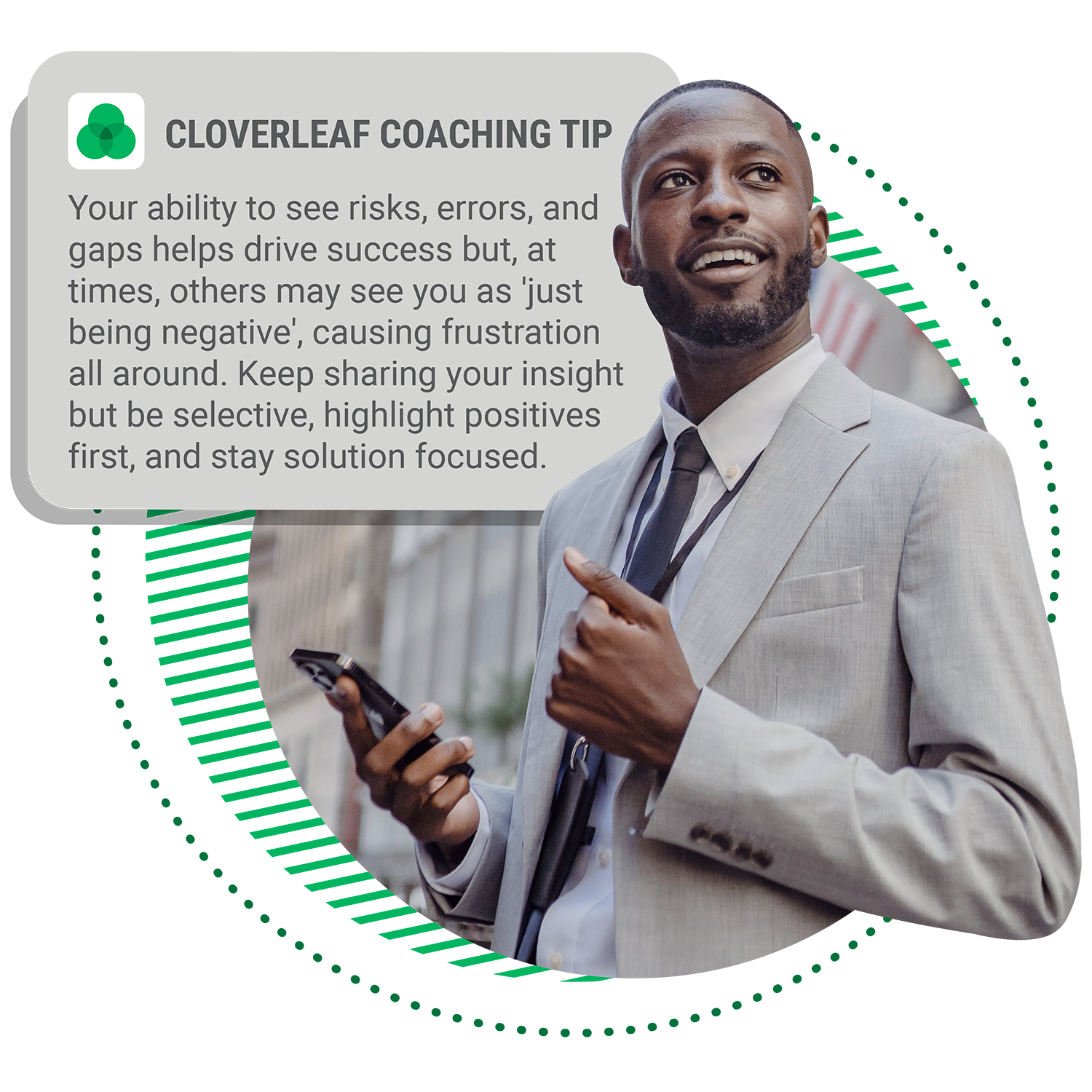
2. Leveraging Technology to Make Coaching Sticky
Coaching doesn’t have to be overwhelming, especially when you have the right technology in your corner. The real transformation begins when you move away from traditional, infrequent performance reviews to more dynamic, ongoing coaching conversations. Tools like Cloverleaf make integrating coaching into your daily routines seamless and impactful.
Think of these tools as your real-time coaching assistant. With instant access to insights into team dynamics and individual strengths, you can tailor your coaching approach on the fly. Imagine having a continuously updated playbook that helps you adjust strategies to fit the unique needs of each team member. Cloverleaf’s real-time coaching tips and visual dashboards are designed to make this easy, providing a clear view of where your team is excelling and where they may need extra support.
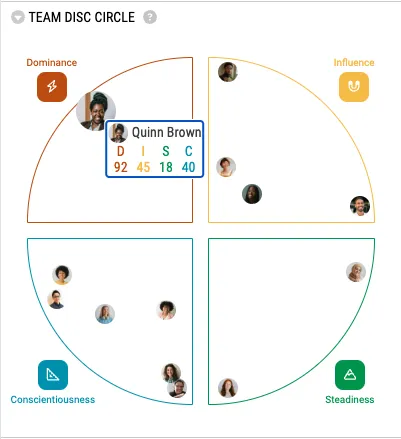
The beauty of leveraging technology is that you don’t need to upend your entire process overnight. Start small by incorporating these tools into your existing workflows. For instance, before your next one-on-one, use a tool like automated coaching to review personalized coaching tips that are contextual based on the individual’s strengths and communication style. This approach not only enhances the effectiveness of your coaching but also demonstrates to your team that you’re deeply invested in their personal and professional growth.
How I Used Cloverleaf To Shift Leaders To A Coaching Approach
In a recent collaboration with one of my clients, we set out to transform their leadership culture by integrating continuous, personalized feedback into their daily routines. The goal was to move away from the traditional once-a-year performance reviews and instead create an environment where coaching conversations happened regularly and naturally.
We introduced Cloverleaf into their daily workflow to make this shift manageable and sustainable. Rather than overwhelming the team with a massive cultural overhaul, we implemented small, iterative changes that gradually embedded a coaching mindset into everyday operations.
Cloverleaf’s visual dashboard quickly became a game-changer. Leaders were able to pinpoint team strengths, identify skill gaps, and recognize opportunities for delegating tasks more effectively. The daily tips feature, integrated into Slack, prepared employees for their interactions, inspiring a coaching mindset across the entire organization. This approach allowed leaders to adapt their leadership style progressively, reinforcing the coaching culture without disrupting the team’s existing processes.
By equipping the team with these tools, we didn’t just initiate a shift; we laid the groundwork for a robust, all-in coaching culture that’s poised for long-term success.
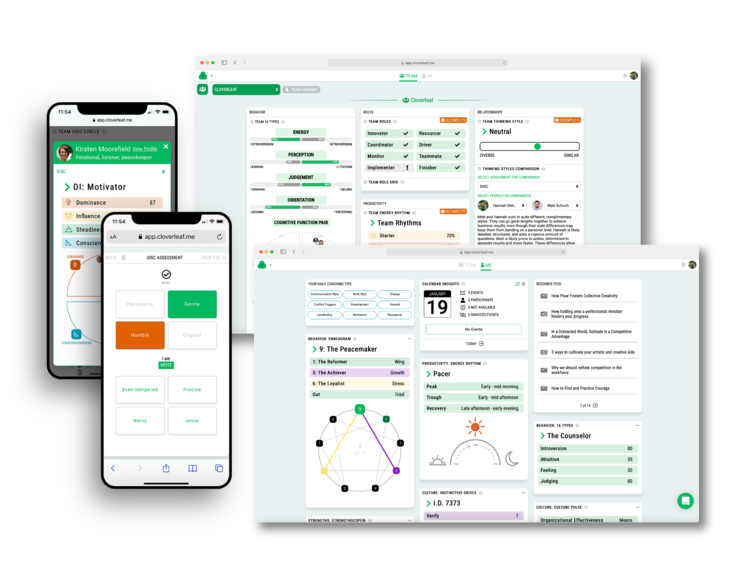
3. Activate the Coaching Mindset
After equipping your leaders with the right training and tools, the challenge shifts to integrating coaching into the daily operations of your organization. This integration facilitates a mindset where coaching becomes a natural, ongoing part of how your teams function and grow together.
Start by establishing regular feedback loops, ranging from quick, informal check-ins to more structured one-on-one sessions. The goal is to normalize feedback as a routine part of your team’s day-to-day interactions, making it easier for team members to reflect, learn, and grow continuously.
Promoting autonomy within your teams is another crucial element. Empower your employees by giving them the freedom to take ownership of their roles and the support they need to navigate challenges. Recognize and celebrate those who exemplify the coaching culture you aim to create. Highlighting these coaching moments reinforces the desired behavior and motivates others to adopt similar practices.
When feedback, autonomy, and recognition are woven into the fabric of your daily operations, the coaching mindset can truly take root. This is how you cultivate an all-in culture, where every team member is engaged, empowered, and contributing to the organization’s success.

How To Ensure Your Coaching Culture Takes Root
Transforming your organization’s culture is no small feat. It’s easy to kick things off enthusiastically—through workshops, events, and all the bells and whistles—but what happens after the initial excitement fades? The true test of a successful coaching culture lies in its longevity and the tangible benefits it brings to your organization over time. – Marnie Robbins, Founder of Vibe People Studio
To ensure your coaching culture sticks, tracking its impact continuously is essential. As the saying goes, “What gets measured gets managed.” Here’s how you can systematically evaluate your culture’s evolution:
- Share Surveys: Conduct surveys regularly to gauge employee sentiment and engagement. These surveys will provide quantitative data on how your team perceives the coaching culture and whether it is creating a positive work environment. Are your employees feeling more empowered? Are they more engaged?
- Gather Feedback: Never underestimate the power of direct feedback. Creating open channels for dialogue allows employees to share their real experiences with the coaching initiatives. This qualitative insight can uncover underlying issues or highlight successes that raw data might miss. It also signals to your team that their voices are heard and valued.
- Conduct Listening Tours: Take a hands-on approach by organizing listening tours where leaders engage with employees across different levels and departments. This method helps bridge gaps between leadership intentions and employee experiences, ensuring that the coaching culture resonates throughout the organization.
- Measure Performance Metrics: Track key performance indicators (KPIs) such as productivity, innovation, and team collaboration. For instance, monitor how customer success scores correlate with employee sentiment. These metrics provide concrete evidence of how the coaching culture influences overall performance, linking cultural shifts directly to business outcomes.
Consistently reviewing these metrics will help you identify where your coaching culture is thriving and where adjustments may be needed. This ongoing assessment enables you to fine-tune your approach, ensuring that your coaching culture aligns with your organizational goals and drives genuine, sustainable success for your team.
Coaching: The Strategic Investment In Your Organizations Future
Adopting a coaching approach isn’t just about enhancing your people initiatives—though that’s a powerful outcome. It’s about aligning leadership strategies with the evolving demands of today’s business landscape. Companies that successfully integrate a coaching culture aren’t just keeping up with the times; they’re positioning themselves to lead, innovate, and thrive. When every team member is engaged, empowered, and contributes to a shared vision, the organization moves forward with a unified strength.
The journey toward a coaching-focused leadership model is more than just a shift in management style—it’s a strategic investment in your organization’s future. By investing in a culture where coaching is the norm, you unlock the full potential of your teams, paving the way for sustained success and innovation.
Do you want to see the impact of automated coaching for yourself? Schedule a Cloverleaf demo today to learn more about scaling the impact of your team coaching program.
As the warm months roll in, many people start to experience what’s commonly known as the summer slump. This phenomenon isn’t just about students forgetting what they’ve learned over the school year; it affects adults, too, manifesting as a drop in productivity and motivation in the workplace. This slump can disrupt carefully laid plans for talent development leaders and hinder progress on critical initiatives.
Understanding the summer slump and how to combat it can help individuals and organizations maintain momentum and achieve their goals even during these relaxed months. Scott Dust, the Chief Research Officer at Cloverleaf and a management professor at the University of Cincinnati brings extensive expertise in management and organizational behavior. Scott provides valuable insights into why the summer slump happens and what leaders can do to keep their teams motivated and productive. “The summer slump is real for adults as well. A summer slump typically entails either a loss in the quantity of productivity or a loss of quality,” says Scott Dust.
Follow along for a data-driven approach that uses personalized coaching insights to turn the seasonal dip into a period of strategic growth and engagement. Scott’s expertise reveals how targeted interventions and continuous development can not only mitigate the effects of the summer slump but also foster a more resilient and adaptable workforce.

What is the Summer Slump for Adults?
The summer slump is a well-documented phenomenon affecting adults in the workplace, characterized by a noticeable decline in productivity and motivation. Unlike the summer slide that impacts students, the summer slump in adults often manifests as both a reduction in the quantity of work produced and a dip in the quality of the work performed.
Research supports the reality of this slump, showing that workplace productivity can drop by approximately 20% during the summer months. Attendance at work also decreases by around 19%, and employees are about 45% more distracted during this period (The HR Team). These declines are primarily due to seasonal factors such as vacations, outdoor activities, and a generally more relaxed pace that summer brings.
For many employees, the warm weather and longer days lead to a natural desire to be outside and more active, which can conflict with workplace responsibilities. This seasonal shift in focus can result in fewer hours worked and a decrease in the effort put into tasks, as people may feel more inclined to relax and take time off.
Understanding these patterns is crucial for talent development leaders as it allows them to implement strategies that can help maintain productivity levels and keep teams motivated. By recognizing the signs of a summer slump and addressing them proactively, leaders can mitigate its effects and ensure that their teams continue to perform effectively throughout the summer months.

HUMAN SKILL PROGRAMS ARE HITTING LIMITATIONS...
- Close the gap between learning and on-the-job application
- Overcome the tension of pausing productivity for development opportunities
- Experience done for you learning in the flow of work
- Stay ahead of human skill development
- Prove the ROI of your talent development programs

The Science Behind the Summer Slump
The summer slump can be better understood through the concept of entrainment, a phenomenon where an individual’s biological rhythms are synchronized with external environmental cues. Entrainment explains how our bodies and minds adjust to signals from our surroundings, influencing our productivity and motivation levels. This concept is pivotal in understanding why productivity can fluctuate significantly during different times of the year and even different days of the week.
Entrainment and Its Relevance to Weekly and Annual Productivity Cycles
Research into entrainment shows that our productivity is not constant but varies in predictable patterns based on weekly and annual cycles. For example, studies indicate that Mondays tend to be the most productive days of the week. This is because, after a weekend of rest, individuals typically feel more refreshed and motivated to tackle their tasks. As Scott Dust explains, Monday is the day that you are supposed to do planning and you’ve just had the weekend to relax, so you should be up and at ’em and ready to charge forward.
Conversely, productivity tends to decline as the week progresses. By Friday, the anticipation of the weekend leads to lower levels of motivation and focus. This weekly pattern of rising and falling productivity is a direct result of entrainment, where individuals respond to the societal norm of a five-day workweek followed by a two-day weekend.
Similarly, annual cycles also play a significant role. During the summer months, longer daylight hours and warmer weather signal a time for outdoor activities and vacations. These signals can subconsciously impact our work behavior, leading to decreased productivity and an increased desire to relax and take time off. Summers are typically when people do a lot of travel, spend more time outside, and enjoy longer days, notes Dust, emphasizing how these seasonal cues contribute to the summer slump.
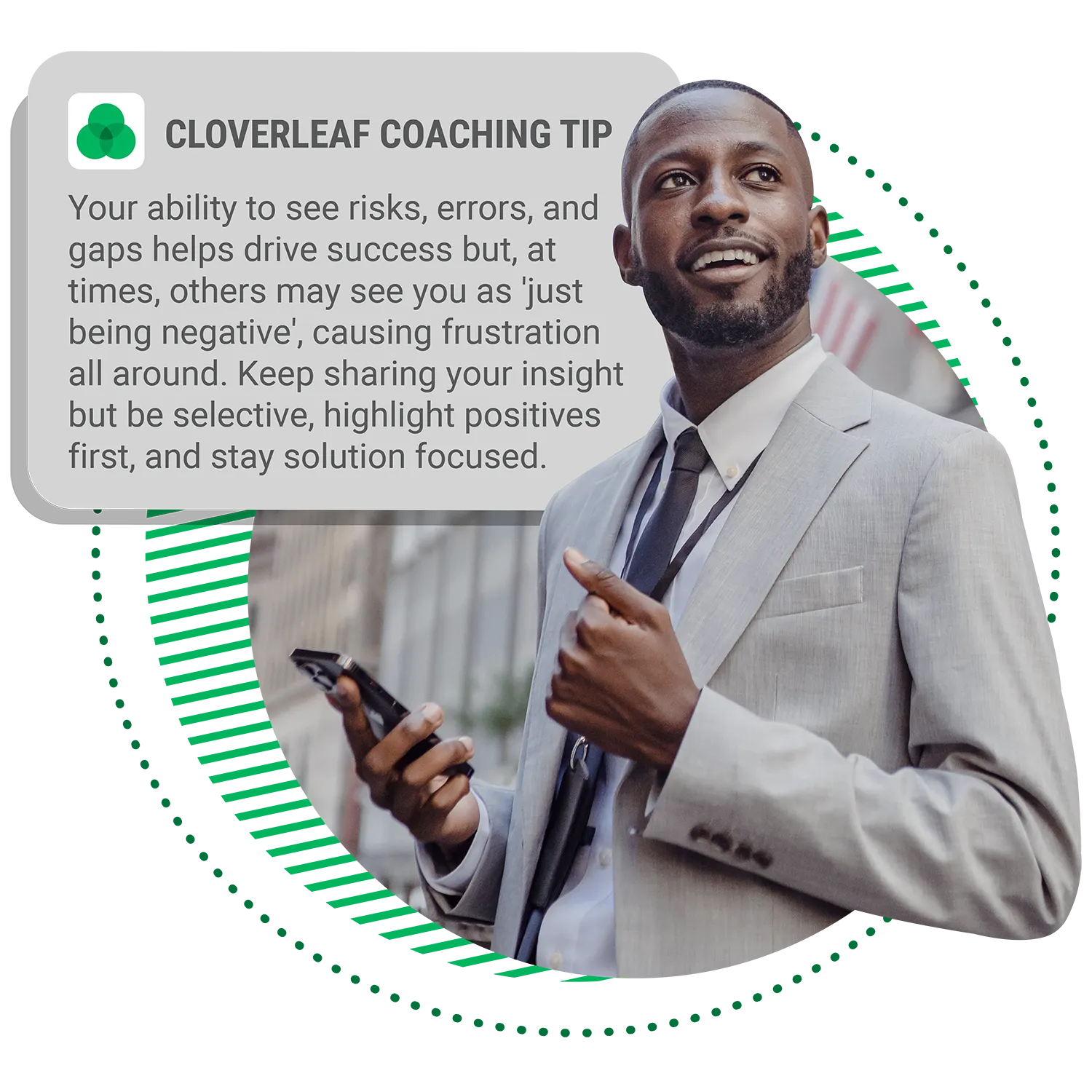
How To Leverage Entrainment Insights To Align Work
By recognizing and adapting to these entrainment patterns, talent development leaders can implement strategies that mitigate the negative effects of the summer slump. This could include flexible working hours, encouraging outdoor breaks, or scheduling important tasks during peak productivity times. Leveraging these insights can help maintain productivity and motivation levels, even during the challenging summer months.
Make sure there’s a balance, and align the type of work with the right time. For example, some people are early birds, which is their chronotype, while others are night owls and do their best work later in the day. Most people fall somewhere in the middle. Knowing this, people should do deep work and meetings at times that suit their chronotype. Apply this mindset to fight the summer slump by aligning work types with the right times of the day and year.
For more information on circadian rhythms and their impact on productivity, you can refer to sources like the National Institute of General Medical Sciences (NIGMS) and Journal of Biological Rhythms (SRBR). Or you can take Cloverleaf’s free chronotype quiz to help you figure out your energy rhythm. These resources provide deeper insights into how biological rhythms influence workplace efficiency and how organizations can optimize work schedules accordingly.
Using Automated Coaching to Alleviate the Summer Slump
Organizations should just roll with it. Recognizing that we’re not robots, and you can’t program human beings to have the exact same productivity every day and throughout every season, suggests Dust. But there are tools that you can use to help individuals adapt to their unique situation. Automated Coaching™ is a strategic approach to maintain and even boost productivity during these months. According to Scott Dust, Embedding coaching into everyday tools means that support and guidance are always at hand, helping employees navigate the distractions and lower motivation levels typical of the summer months.
Automated Coaching provides coaching insights in the flow of work personalized to the individual’s situation. It democratizes coaching, making it scalable through technology. It starts with assessments like 16 types, Enneagram, DISC, and strength-based assessments to understand who you are.
The tool uses algorithms and expert insights to design interventions and suggestions based on your situation. Whether meeting with specific people or being part of a group, you get nudges on how to be the best possible you in that situation. This deep personalization helps employees understand their strengths and areas for improvement, to encourage a growth mindset, at all times throughout the year.
16 Types: Helps identify cognitive preferences, aiding in decision-making and information processing. By understanding how they process information and make decisions, employees can approach tasks in a way that aligns with their natural tendencies, leading to increased efficiency and effectiveness.
Enneagram: Explores core motivations and fears, offering strategies to manage behavior. Recognizing what drives them and what they fear allows employees to address underlying issues that may be hindering their performance, particularly during the less structured summer months.
DISC: Categorizes behavior to improve communication and collaboration. Understanding their own and their teammates’ behavior styles can significantly enhance communication and reduce misunderstandings, fostering a more cohesive and productive team environment.
Benefits of Personalized Coaching Insights
Different types of traits might align with different types of work throughout the year. For example, introversion vs. extroversion or openness to experience can influence the type of work people prefer. In the summer slump, extroverts might enjoy more networking, while those high in openness might embrace new experiences. Personalized coaching insights offer several key benefits that are particularly relevant during the summer slump:
Enhanced Individual Performance: When employees are aware of their cognitive preferences and motivations, they can structure their work in a way that maximizes their productivity, even when external distractions are high.
Improved Team Dynamics: During the summer, when team members might be working different schedules or remotely, understanding these dynamics becomes even more crucial for maintaining team cohesion and effectiveness.
Continuous Development: The summer can be an ideal time for personal development, as employees might have more flexibility to engage in learning opportunities.
By integrating coaching into daily routines, we can help employees stay focused and productive, turning the summer slump into an opportunity for growth. Cloverleaf is dedicated to developing essential human skills, such as emotional intelligence, resilience, and collaboration. Automated Coaching™ delivers micro-learning nudges that reinforce these real-life skills, helping team members navigate challenges, adapt to change, and work more collaboratively with their teammates. This focus on human skills not only improves individual performance but also drives organizational success.
In the hustle and bustle of the modern workplace, there’s a subtle undercurrent that often goes unnoticed, yet it holds immense power. We’re talking about psychological safety, a concept that, when nurtured, can transform the dynamics of a team.
Imagine a workspace where every opinion is valued, where you can voice your thoughts without the fear of being shot down. This is the essence of psychological safety. It’s more than just a feel-good factor; it catalyzes innovation and collaboration.
Harvard Business School Professor Amy Edmondson, a pioneer in this field, eloquently described psychological safety as a sense of confidence that the team will not embarrass, reject, or punish someone for speaking up. It’s about creating a space where diverse thoughts aren’t just tolerated but celebrated.
But why should organizations pay attention? Well, the numbers speak for themselves. A staggering report from Gallup revealed that only 8% of U.S. workers strongly believe that their opinions matter at work. This disengagement doesn’t just lead to a lackluster work culture; it costs the U.S. economy hundreds of billions of dollars every year.
Navigating the nuances of a workplace can be akin to walking a tightrope. As we begin to dig into what psychological safety is, it’s equally crucial to start by understanding what it isn’t. Let’s unravel the layers that obscure the path to a psychologically safe environment.

Exploring the Absence of Psychological Safety
It’s easy to mistake conformity for psychological safety. However, these are two distinct realms. A workplace absent of psychological safety is one where dissent is stifled, and the fear of retribution looms large.
Consider when disagreements are met with a cold shoulder or, worse, punitive measures. In such spaces, employees walk on eggshells, suppressing their authentic selves to fit into a mold crafted by unspoken norms and expectations.
The Undermining Forces
So, what undermines psychological safety? The culprits are often socialized pressures that subtly dictate how one should behave. These unwritten rules create an environment where members of a team feel compelled to don masks, concealing their thoughts and feelings in fear of negative consequences.
For instance, the belief that “leaders always have the answers” or “admitting a mistake is a sign of weakness” can lead to a culture where individuals are hesitant to voice their concerns or share ideas. This stifling atmosphere not only hampers creativity but also sows seeds of discontent, leading to burnout and disengagement.
The Cost of Silence
The repercussions of a lack of team psychological safety are profound. When employees are hesitant to share their insights or challenge the status quo, opportunities for innovation and improvement are lost. The silence that pervades such environments is not a sign of agreement but a symptom of a culture that hasn’t embraced the richness of diverse perspectives.
In essence, understanding what psychological safety is not helps us to appreciate its value better and guides us in fostering a workplace where every voice is heard, respected, and valued.
Q&A: Unraveling Psychological Safety
To delve deeper into the concept of psychological safety, let’s explore some frequently asked questions and identify signs that indicate the presence or absence of psychological safety in a workplace.
Q: What exactly is psychological safety?
A: Psychological safety refers to an individual’s perception of the consequences of taking an interpersonal risk. In a psychologically safe environment, employees feel comfortable expressing themselves without fear of retribution or judgment.
Q: Why is psychological safety crucial in the workplace?
A: Psychological safety fosters an atmosphere of trust and openness, leading to increased creativity, collaboration, and overall productivity.
Q: How can leaders foster psychological safety within their teams?
A: Leaders can encourage open dialogue, admit vulnerability, celebrate diversity, and provide training to ensure a psychologically safe environment.

HUMAN SKILL PROGRAMS ARE HITTING LIMITATIONS...
- Close the widening gap between learning and on-the-job application
- Overcome the tension of pausing productivity for development opportunities
- Integrate learning so it is actually in the flow of work
- The evolution of human skill development
- What Automated Coaching™ is and how it works.

The Significance of Psychological Safety: A Cornerstone for Thriving Workplaces
Why Psychological Safety is Indispensable in the Workplace
Psychological safety is not merely a bonus in the workplace; it’s an essential element. It lays the foundation for trust, nurtures open communication, and cultivates team effectiveness. When individuals feel secure in sharing their thoughts and ideas, the workplace transforms into a vibrant space of creativity and collaboration.
Edmondson’s insights resonate deeply here. She emphasizes that the fear of speaking up can be so overwhelming that it inhibits cognitive processes. This apprehension stifles the creativity and innovation that are vital to an organization’s growth.
Google’s Project Aristotle: A Case Study in Team Psychological Safety
Google, in its quest to understand the dynamics of effective teams, embarked on an initiative known as Project Aristotle. The tech giant delved into a myriad of factors, from hard skills to soft skills, in an attempt to decipher the secret sauce behind successful teams.
The results were enlightening. Google found that the linchpin of high-performing teams was not their skills or resources but the presence of psychological safety. This environment of mutual respect and openness allowed team members to take risks without fear of backlash.
Psychological Safety Is A Differentiator
A 2015 study by Google underscores the importance of psychological safety, identifying it as one of the fundamental dynamics that set successful teams apart from the rest. In environments where psychological safety was prevalent, teams were more cohesive, innovative, and, ultimately, more successful.
The emphasis on psychological safety is not just about fostering a positive workplace. It’s about unlocking the full potential of every team member and, by extension, the organization itself. By understanding and championing psychological safety, businesses can cultivate workplaces that are not just productive but also places where individuals have an incredible employee experience.
5 Characteristics of a Psychologically Safe Workplace: Unveiling the Elements of a Supportive Environment
A psychologically safe work environment is akin to a nurturing ecosystem where ideas flourish, and individuals thrive. But what does this environment look like, and how can we identify it?
Problem-solving teams need two critical things…. The first is psychological safety and cognitive diversity (Harvard Business Review), underscoring the importance of an environment where diverse thoughts are welcomed and respected. Let’s delve into the characteristics that define such a safe space.
Characteristics of a Psychologically Safe Workplace
1. Open Communication: In a psychologically safe workplace, communication is transparent and open. Team members feel comfortable sharing their thoughts, knowing their voices are valued.
2. Respect for Diversity: Cognitive diversity is celebrated, and different perspectives are seen as assets that enrich discussions and decision-making processes.
3. Emphasis on Learning: Mistakes are viewed as opportunities for learning and growth rather than failures that warrant punishment.
4. Supportive Atmosphere: Employees support each other, fostering a sense of belonging and camaraderie.
5. Encouragement of Risk-taking: Innovation is encouraged, and interpersonal risk-taking is seen as a part of the creative process.
Identify Red Flags
While understanding the characteristics of a psychologically safe workplace is essential, it’s equally important to recognize the signs that may indicate a lack of such safety. Being proactive in identifying these red flags can help foster a supportive environment:
1. Reluctance to Speak Up: In a psychologically safe workplace, employees feel comfortable sharing ideas. A hesitation to voice concerns may indicate a lack of safety.
2. High Stress Levels: A supportive environment promotes well-being. Persistent stress among team members could signal a need for improvement.
3. Frequent Conflicts: Regular disagreements within teams may suggest an absence of psychological safety.
4. Low Employee Engagement: A psychologically safe workplace encourages active participation. Disinterest in team activities can be a red flag.
By being vigilant about these signs, organizations can take timely action to reinforce the elements contributing to a psychologically safe and supportive environment.
Providing Psychological Safety In A Hybrid Work Model
The shift towards remote collaboration and hybrid work models has introduced new challenges in maintaining psychological safety, making it essential to adapt and integrate supportive elements seamlessly.
4 Characteristics of a Psychologically Safe Remote Workplace
1. Consistent Check-ins: A psychologically safe workplace, whether remote or in-person, ensures regular interactions. Virtual meetings can help employees feel connected and valued.
2. Inclusive Communication: A supportive environment utilizes tools that ensure everyone, regardless of location, has an opportunity to contribute.
3. Virtual Team-Building: Activities that foster camaraderie and trust among remote teams are characteristic of a psychologically safe workplace.
4. Adaptability: A continuous effort to adapt to changing work trends is a hallmark of a supportive environment.
By integrating these characteristics, organizations can ensure that employees, regardless of their work setting, experience a sense of psychological safety and feel supported and valued, regardless of their location.

A Glimpse into a Psychologically Safe Workplace
Creating a psychologically safe work environment requires fostering the shared belief that individuals can be themselves, voice their thoughts, and contribute to their fullest potential. By understanding and supporting these characteristics, organizations can create workplaces that are not only productive but also profoundly enriching for every team member.
Joe’s Transformation
In a global financial institution, Joe, a dedicated software developer, was known for his heads-down work. However, assessments revealed that his natural strengths leaned towards leadership. Recognizing this, the team decided to let Joe lead a standing five-minute meeting every day. This small change allowed Joe to tap into his leadership skills and significantly shifted his engagement levels. He began actively participating in discussions, spreading his energy to other meetings. This supportive atmosphere led not only to an increase in Joe’s engagement but also positively impacted the team’s overall dynamics and productivity.
Michael and Sarah’s Improved Collaboration
Another story that stands out is Michael, a small business owner, and his employee, Sarah. In team meetings, Sarah consistently rebutted Michael’s suggestions, creating tension. However, some coaching helped Michael understand that Sarah’s questions were aimed at understanding, not challenging. When Michael approached Sarah with empathy and curiosity, the dynamic shifted. Sarah felt heard, and her questions strengthened teamwork.
Small changes, such as understanding one’s strengths and fostering open communication, can impact employee retention, personal relationships, and overall well-being.
Building Psychological Safety: A 4 Step Blueprint for Success
How to Foster Psychological Safety in the Workplace
Creating a psychologically safe workplace is not a one-time effort but a continuous journey. Leadership plays a pivotal role in this transformation. Leaders set the tone for the organization, and their actions and attitudes can either foster or hinder the development of psychological safety.
Simon Sinek, a renowned leadership expert, encapsulates this idea perfectly: A team is not a group of people who work together. A team is a group of people who trust each other. Trust is the bedrock of psychological safety, and leaders must actively work to cultivate it.
4 Actionable Steps for Leaders
1. Encourage Open Dialogue: Leaders should create an environment where open communication is encouraged. This means actively seeking diverse opinions and creating spaces for discussions. This aligns with the first stage of psychological safety, Inclusion Safety, as outlined by Timothy R. Clark in his book, The 4 Stages of Psychological Safety, where individuals need to feel accepted and included.
2. Admit Vulnerability: Leaders can set an example by admitting their mistakes and showing that it’s okay not to have all the answers. This fosters Learner Safety, the second stage defined by Clark, where team members feel safe to engage in the learning process, ask questions, and make mistakes.
3. Celebrate Diversity: Embracing cognitive diversity and different perspectives can lead to richer discussions and better problem-solving. This step is crucial in establishing Contributor Safety, the third stage, where individuals feel safe to apply their skills and contribute to the team’s objectives.
4. Provide Psychological Safety Training: Equip your team with the knowledge and tools they need. Amy Edmondson’s book, The Fearless Organization, and her TEDx talk on building a psychologically safe workplace are excellent resources. Additionally, training can help teams reach Challenger Safety, the fourth stage identified by Clark, where individuals feel empowered to challenge the status quo and propose innovative ideas.
From my own experience, adapting my leadership style was a journey of self-discovery. I realized that by being more open and encouraging my team to share their thoughts without fear, we were able to foster a sense of belonging and safety. This shift not only improved our team dynamics but also led to more innovative solutions.
Consider Pixar’s “Braintrust” Meetings:
Pixar Animation Studios offers a brilliant example of psychological safety in action. Their “Braintrust” meetings are designed to provide candid feedback on ongoing projects. The environment is structured to ensure that the feedback is constructive and free from hierarchical constraints, allowing for honest discussions and creative problem-solving.
Building psychological safety is an ongoing process that requires commitment from leadership and active participation from all team members. By implementing these steps and learning from successful examples, organizations can create an environment where everyone feels safe contributing, leading to more incredible innovation and success.
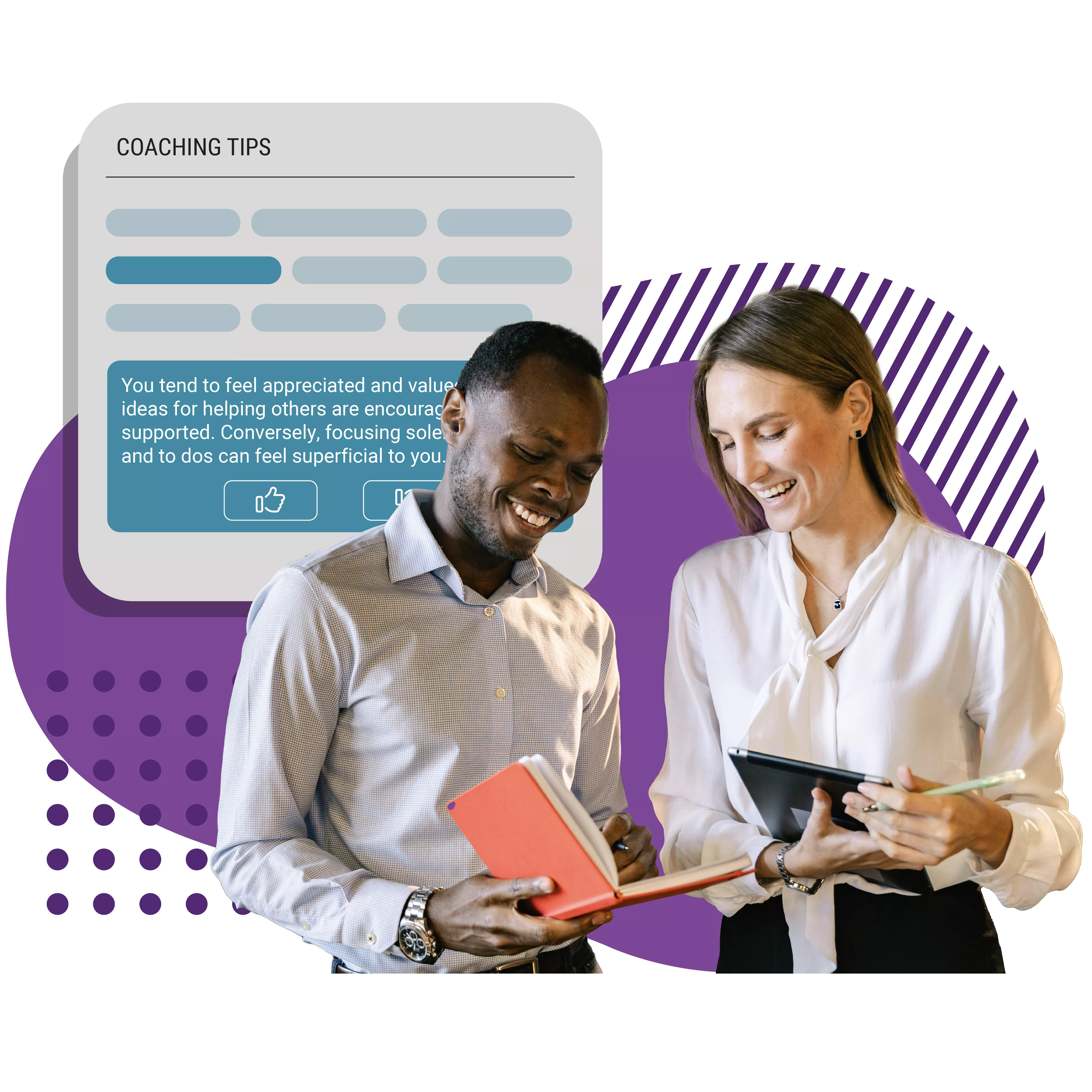
Integrating Tools to Enhance Psychological Safety
Cultivating a supportive workplace is a nuanced endeavor beyond leadership initiatives and open communication. It involves embedding continuous learning and insightful tools into everyday work experiences. For instance, platforms like Cloverleaf can seamlessly integrate into daily workflows, offering insights to improve communication and collaboration among teammates.
In a supportive work culture, continuous learning becomes the norm. By understanding themselves and their colleagues better, individuals can foster an environment that thrives on mutual respect and openness. This shift is not just about personal development; it can shift the entire culture of organizations. When equipped with the right insights, teams can unlock fulfilling and productive dynamics to reap the benefits of psychological safety.
Accessibility to intuitive and actionable data is also crucial. Tools that provide easy-to-understand insights empower individuals and teams to make informed decisions, contributing to a more supportive and inclusive environment. These tools can be subtle yet powerful facilitators in fostering a culture where every voice is valued and authenticity is celebrated.
In essence, the journey toward a psychologically safe workplace is enriched by practices and tools that encourage understanding and open communication. By integrating platforms that offer insights into individual and team dynamics, organizations can take a holistic approach to building a culture where individuals feel valued, heard, and encouraged to be their authentic selves.
Conclusion: The Path Forward
In the dynamic and constantly shifting environment of modern workplaces., prioritizing psychological safety is not just a necessity but a commitment to fostering a culture of trust, innovation, and collaboration. As we navigate the complexities of team dynamics, leadership roles, and organizational goals, psychological safety is a beacon of hope.
Embracing Vulnerability
Brené Brown, a renowned researcher and storyteller, encapsulates the spirit of psychological safety when she notes, “Vulnerability is not winning or losing; it’s having the courage to show up and be seen when we have no control over the outcome.” This sentiment resonates deeply with the ethos of a psychologically safe workplace. It’s about creating an environment where vulnerability is seen not as a weakness but a strength, where individuals are encouraged to bring their authentic selves to the table.
The path forward requires a commitment to continuous learning and development. Organizations must actively seek ways to embed psychological safety into their cultures, ensuring that it permeates every interaction, decision, and strategy. It’s about recognizing that the journey toward a psychologically safe workplace is ongoing and requires consistent effort.
A Call to Action
As we conclude our exploration of psychological safety, the call to action is clear. Organizations must prioritize creating environments where employees feel seen, heard, and valued. By doing so, we pave the way for workplaces that are not just productive but also nurturing spaces that foster creativity, innovation, and mutual respect.
In essence, the path forward is one of commitment and action toward ensuring that psychological safety is not just a buzzword but a lived reality in our workplaces. By embracing vulnerability, encouraging open dialogue, and continuously striving for improvement, we set the stage for a future where every workplace is a haven of psychological safety and collaborative success.
